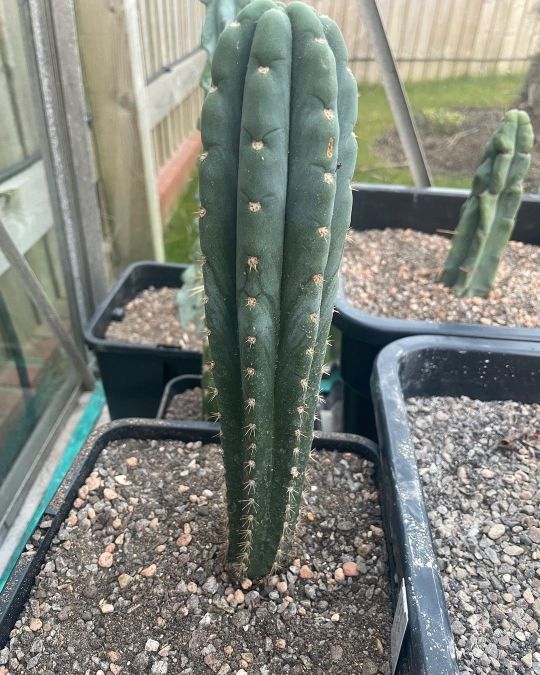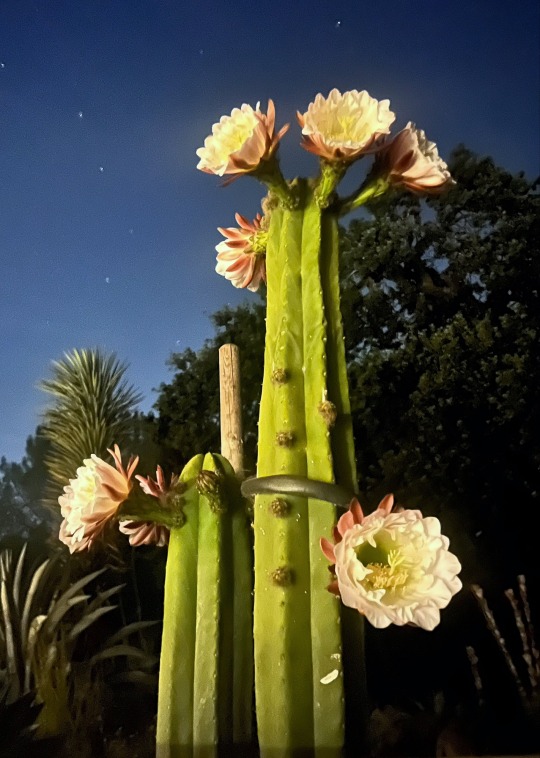#Trichocereus pachanoi
Explore tagged Tumblr posts
Text
youtube
Welcome to Cactocereus Ltd t/a Trichocereus UK, for cactus lovers, by a cactus lover. This is your one stop shop to buy San Pedro cactus in the UK.
On the store, you will find all the plants that I am currently growing for sale, I will add more as seedlings become viable for sale.
I focus mainly on Trichocereus and Lophophora strains with a large selection of pure strain & hybrids soon to be available, including:
Trichocereus Pachanoi
Ikaros DNA (A very special Trichocereus Peruvianus)
Trichocereus Terscheckii
Trichocereus Peruvianus
Lophophora Wiliamsii
Pachanoi X Bridgesii
Bridgesii X Peruvian
Pachanoi X Peruvian
You can see the full list of seedlings and their status here.
I will also offer seeds as and when I get them, all seeds will be fresh so will have a high germination rate.
My goal is to bring these wonderful cacti to as many UK households as possible.
There will also be the odd graft available in the near future.
1 note
·
View note
Photo

🌵 Plant of the Day - Tr. Ichoca OP 🌵 This gorgeous specimen is true to his parent clone, notches coming through nicely. Only a few took on the traits of the Ichoca clone, this is one of em. . . . . . . . #ichoca #trichocereus #trichocereuspachanoi #trichologist #pachanoi #sanpedrocactus https://www.instagram.com/p/ConCP8YLS1w/?igshid=NGJjMDIxMWI=
0 notes
Text

Trichocereus macrogonus subsp. pachanoi
We got this cactus as Trichocereus scopulicola, but its proper name is a matter of much debate. It belongs to a group of columnar plants from the Andes, including the San Pedro Cactus (Trichocereus pachanoi). I have labeled the photo according to the classification of Joel Lode, but other authorities refer it to Trichocereus bridgesii or Trichocereus lageniformis. In any case, the large flowers open in the evening, and my colleague Tawny was at the garden late enough to capture this photo with the stars visible in the sky.
-Brian
260 notes
·
View notes
Text

This Ecuadorian Trichocereus pachanoi was in urgent need for a new pot and soil. I had used a soil that mostly consisted of large particle Lava and it turned out to be too fast draining for my plants. All plants I used that soil on looked a bit dehydrated and didn´t flower as good as they could have. So I decided to completely jump onto the Pumice train and repot all the Lava pots into Pumice based mixes. And it worked...roughly two years after recording this video the plants look SO MUCH BETTER now. And don't get me wrong....Lava is an amazing additive to cactus soil. It´s just too fast draining for using it as sole medium. Mixing in a bit of Lava here and there will work awesome, especially if you want to improve the drainage of your soil.
youtube
6 notes
·
View notes
Photo

Echinopsis pachanoi, aka Trichocereus pachanoi. Full flowering and very popular with bees. (at Paloma Gardens) https://www.instagram.com/p/Cn-wYNuJkoC/?igshid=NGJjMDIxMWI=
0 notes
Text
[ID: Three Wikipedia screenshots, with text:
Taxonomy
Studies in the 1970s and 1980s resulted in several formerly separate genera being absorbed into Echinopsis:
Acantholobivia Backeb.
Acanthopetalus Y.Itô
Adenea Fric (nom. inval.)
Aureilobivia Fric (nom. inval.)
[etc]
Some have proposed merging Rebutia as well.^[who?]
Like several other taxonomic changes in Cactacae, this one has not been universally accepted. Amateur and professional growers still use names like Echinopsis (in the older sense), Lobivia, Setiechinopsis and Trichocerus, although many of the others listed above fell out of common usage long before the change.^[citation needed]
Changing the genus name necessitated using some different specific epithets to avoid creating duplicate names. Thus both Echinopsis bridgesii and Trichocereus bridgesii previously existed. These are very different plants: Echinopsis bridgesii is a chort clumping cactus, whereas Trichocereus bridgesii is a tall columnar cactus similar to E. (or T.) pachanoi. Under the new classification, Trichocereus bridgesii becomes Echinopsis lageniformis.^[citation needed]
The genus name Trichocereus was given to a number of columnar cacti in 1909 by/end transcript.
The final image is the "It's free real estate" meme, with the caption "It's colonialism." End ID.]
(Poorly organized long ass post about poorly organized botanical names incoming)
One thing that frustrates me at work is the emphasis everyone puts on Latin taxonomy names as absolutely correct. Like, it is definitely helpful to differentiate plants and make certain you have exactly the right plant and everything, especially when it’s a better understood and researched genus, but it’s not always a better description than just using the regional common name, especially if it’s a cactus or other plant native to the Americas, where a lot of societies already had an organized taxonomy tailored to their biomes (not that I know a ton of these names yet, to be honest :/) OR the plants just have practical, descriptive, and specific common names in English/Spanish etc.
European “scientific” naming conventions come hand-in-hand with the biases of colonizers’ unfamiliarity with the environment and dismissal of the knowledge of indigenous people’s. Rather than cataloguing plants and genuinely trying to understand them, Europeans in the early colonization of the continents were more inclined to define plants by what they already knew about European plants, and put a lot in boxes that really didn’t fit. This lingers still in our current scientific treatment of these plants. And furthermore, stripping plants of their traditional names and replacing them with “correct” European names was and is still absolutely a tool of oppression, and made our native plants less accessible.
Cacti especially get reclassified constantly as more research is done, so their Latin names change All. The. Time. Lobivia echinopsis (Lobivia being an anagram for Bolivia) is now called Lobiviopsis OR Echinopsis interchangeably, and Echinopsis in general is messy - these are some excerpts from Wikipedia I thought were interesting:

(the list goes on to include 29 genera of cacti)


like they gave out all these names without any genetic information and all these researchers were doing their own thing and it’s messy and inconsistent and often much less scientifically categorized than the names the plants already had.
Latin names have a lot of faults like any other naming system, because we don’t magically know all the genetic history of every single species in order to accurately classify them, and they were named by individuals without necessarily having any real scientific review or standardization, but it’s still held up as this infallible, scientific and 100% accurate system.
(Also relevant, check out how much shit in that article isn’t even backed up by any sources)
People in the U.S. treat Latin botanical names as inherently better and more scientific simply BECAUSE it’s Latin, no matter how much information they’re actually giving me

Labeling something as “Opuntia” isn’t helpful at all - Opuntia is a HUGE genus, which includes all prickly pear and cholla cacti (although chollas aren’t even mentioned at all in the Wikipedia page for the genus). It doesn’t really tell you much about it’s specific growth and what to expect from the plant. If you can tell me Opuntia macrocentra or Opuntia engelmannii var. linguiformis, I can find you your plant, but if you just know it’s an Opuntia? Tell me what it fucking looks like. “Cow tongue cactus” (by the way, “linguiformis” is named after the common name in this case anyway, which is often the case for cacti) is much more descriptive, and so is “I don’t know, it’s the purple one with more spines.”
Tecoma stans is the name I have to use at work for Esperanza, but it’s much more helpful to just tell me if you’re looking for yellow bells/jubilee or esperanza/trumpet vine because the species varies a LOT and the options look and behave very differently.
I’m not trying to say that Latin botanical names suck and they’re always unhelpful or inaccurate or anything like that - I’m thankful to have a relatively comprehensive and widespread system where species for the most part have unique names, especially when several plants share the same common name or one common name can refer to a bunch of different plants. They’re something very helpful that I’m glad to have as a tool. But I really wish people in general kept in mind the limitations of the systems they use, and thought more about why it is that they’re considered “standard.” Colonialism creeps into everything it touches and it has to be intentionally searched for and rooted out, especially in how we interact with nature.
(I really only looked at Wikipedia and went off shit I’ve been thinking about to write this, so it’s definitely possible some info is outdated or not completely accurate)
#botany#this is a banger post one of my favorites ever maybe#also filed under topics I'm afraid to bring up with my paleontology profs#because I would love to be uncontroversial in one class ever please god
60 notes
·
View notes
Text


New trich. Bridgesii to add to the collection! As well as this t. Pachanoi! I have three more pachanoi coming to me soon! Two monstrose and a gorgeous cultivar I havent grow yet!
#cactus#San Pedro#trichocereus#trichocereus bridgesii#trichocereus pachanoi#desert plants#indoor growing#cacti
12 notes
·
View notes
Text

Lophophora graft is taking off.
1 note
·
View note
Text
san pedro cactus stars

9 notes
·
View notes
Text

Cactocereus UK is a small family run business that is obsessed with all things cacti. We specialise in Trichocereus (Echinopsis) and Lophophora williamsii including San Pedro, Peruvian Torch, Bolivian Torch, Scopulicola and Peyote. Our plants are grown with love and attention so that we can spread these wonderful plants as far through the UK as possible.
Address: 65-67 Church St, Sutton-In-Ashfield, England, NG17 1FE
Phone: +447990931943
Website URL: https://www.cactocereus.co.uk/
0 notes
Photo

Decided to repot these Super Pedro x Pachanoi seedlings, am quickly regretting that thought now 😂😂. There are some beautiful dudes in here, will be listed this week 🌵🌵😎. . . . . #trichocereus #superpedro #pachanoi #trichocereuspachanoi https://www.instagram.com/p/CoCo7I1o9G_/?igshid=NGJjMDIxMWI=
0 notes
Text

@djnionas any thoughts on what I should do here? It didn’t have any trauma, so I’m not sure why it’s gone this route ...
41 notes
·
View notes
Text

Trichocereus pachanoi/Echinopsis pachanoi
Their roots were coming through the net that was holding them in, so I figured it was time for a new home.
#Trichocereus pachanoi#Echinopsis pachanoi#psychoactive plants#cacti#succulents#plantblr#san pedro cactus
22 notes
·
View notes
Video
youtube
Trichocereus pachanoi x Echinopsis calorubra Hybrid SAARWELLEN!
Autenrieth hybrid SAARWELLEN from the cross Pach x Echinopsis calorubra. The latter is a regional form of Echinopsis obrepanda and is very useful for hybrid culture. The flower color is classic for hybrids with Echinopsis obrepanda, but the body is actually a columnar plant like Trichocereus pachanoi. The spines on the body are very long and strong, and were heavily influenced by the father. Body from Trichocereus, flower color and spines from the Echinopsis.
0 notes
Text

Pachanoi Smoothie
🌵🍹🌵
Echinopsis Pachanoi aka
Trichocereus Pachanoi
San Pedro Cactus
#Echinopsis#Pachanoi#Trichocereus#Echinopsis pachanoi#Trichocereus pachanoi#San Pedro#Cactus#Smoothie#Psychoactive#More Ginger Less Nausea#Ginger#Veganalicious#Spiritual Smoothie
1 note
·
View note
Photo

SAN PEDRO
#echinopsis pachanoi#trichocereus pachanoi#cactaceas#cactaceae#cactus#mescalina#mescaline#abuelo#enteogeno#medicina natural#san pedro
2 notes
·
View notes